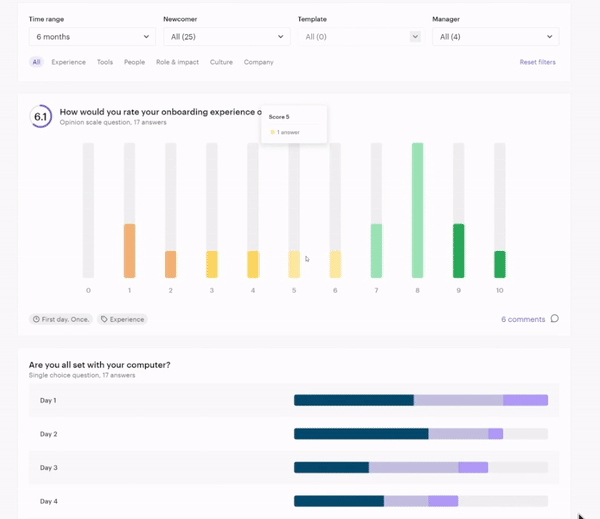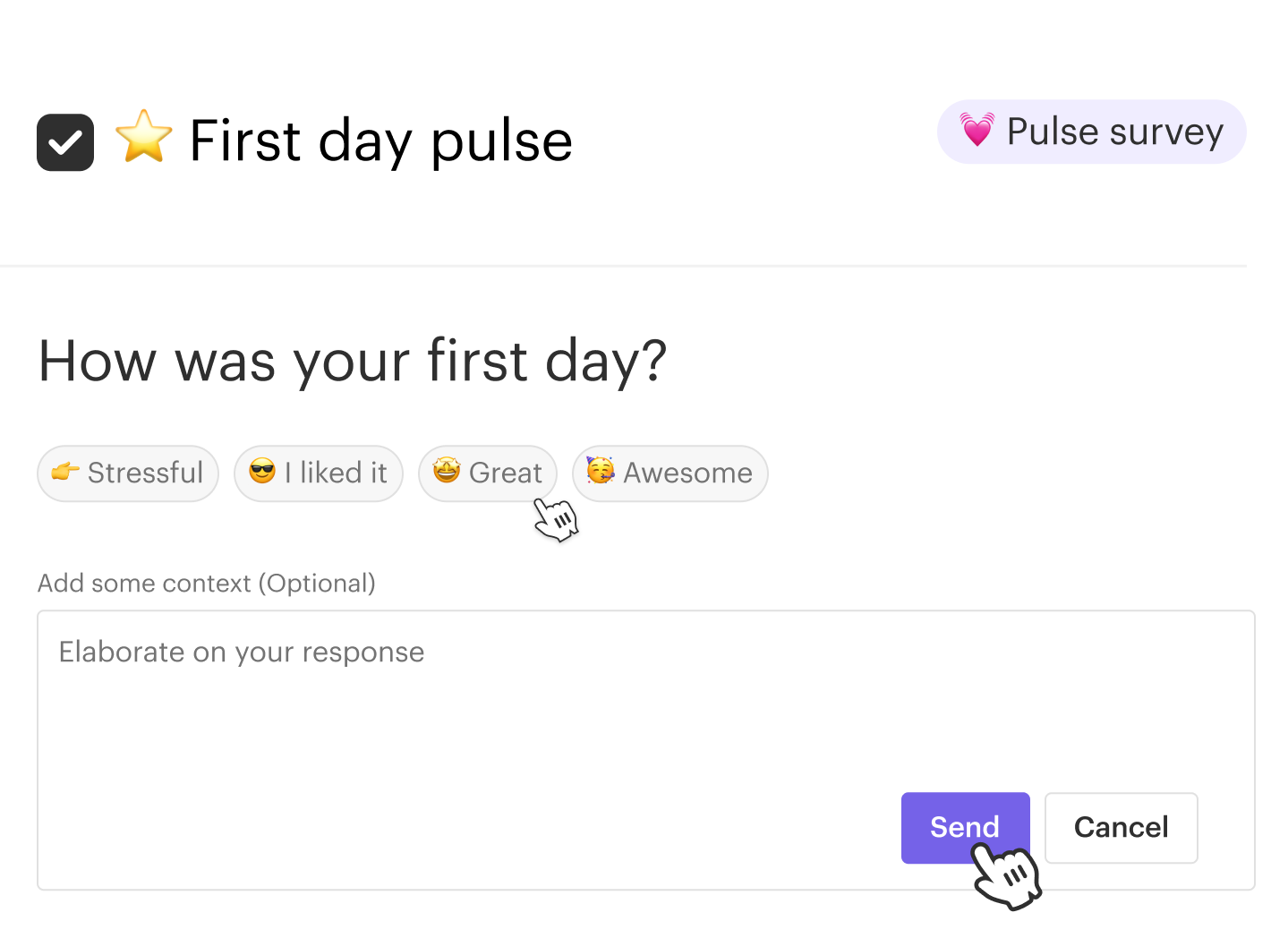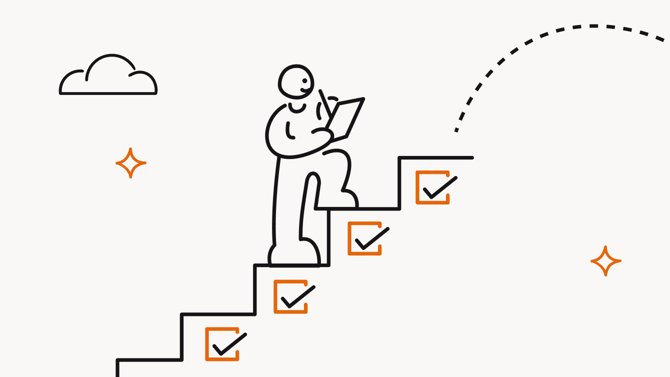As an HR manager, you know how challenging it can be to onboard new hires. It's a time-consuming and often overwhelming process that can lead to low employee engagement, productivity, and retention. The barrage of paperwork, meetings, and HR jargon on their very first day can leave new employees feeling frustrated and disoriented.
But what happens after the first day? What if you don't have a clear understanding of how new hires are engaging with the onboarding process or where they're getting stuck? This lack of insight can make it difficult to identify which departments are struggling with onboarding and why certain employees are leaving after only a short period.
These are the questions that can keep you up at night. Without clear data on your onboarding process, you can't make informed decisions to improve it. This guessing game can leave you struggling to understand why new hires are leaving or which departments are experiencing difficulties.
Exclusive online summit
·
May 23 2024
Moments that matter: how to seed great work
What's in this article
By improving your onboarding process, you can boost employee engagement, productivity, and retention. So it's essential to have a clear understanding of what's going on during the onboarding process. That way, you can identify any areas that need improvement and make data-driven decisions to create a more effective, stronger onboarding process.
Why Measuring Your Onboarding Process is Important
Measuring the success of your onboarding process is crucial to ensure that your new hires feel supported and engaged from day one. It's no secret that first impressions matter, and this is especially true in the workplace. In fact, up to 20% of employee turnover happens in the first 45 days, which is why it's essential to get onboarding right.
Tracking the performance of your onboarding process helps you identify areas that need improvement, and make proactive adjustments to ensure that your new hires are set up for success.
You'll also be able to customize your onboarding process to meet the specific needs of your organization and ensure that your new hires are getting the support they need to thrive.
As an HR manager, making proactive and guided adjustments to your onboarding process can make a big difference in your ability to excel at your job. With a well-designed onboarding process, you'll be able to attract and retain top talent, increase employee engagement, and drive business success.
🎉 Introducing Onboarding Pulse Surveys and Reports 📊
Making sure new employees feel welcome and supported when they start working is really important, but it can be hard to know how well you're doing it. One way to figure it out is to measure how effective your onboarding process is, but that can be a bit overwhelming. Luckily, Workleap Onboarding has just the solution for you: Onboarding Pulses and Surveys. These tools make it easier to evaluate your onboarding process and know where to focus your efforts for improvement.

With Workleap Onboarding and our Pulse Surveys and Reports, you can create an outstanding onboarding process by leveraging the helpful feedback it provides. Say goodbye to the guesswork and hello to a goldmine of insights.

We understand that it can be difficult to figure out where to begin when it comes to gathering feedback. That's why we've got your back. We have made it easy for you to gather valuable insights with our onboarding plans. Each plan includes a Default survey that is already enabled for all new onboarding plans you start right out of the box. This survey will help you collect tailored feedback from new hires, hiring managers, and other stakeholders involved in the process without any extra effort on your part.
With this new feature, you'll be able to identify trends, understand how new hires are engaging with the process, and discover any gaps or pain points in your onboarding process. It's like having a GPS for your process, providing real-time feedback and ensuring everyone knows where they are and where they need to go.
Organizations with a strong onboarding process improve new hire retention by 82% and productivity by over 70%.
The Brandon Hall Group
But that's not all - our detailed analytics and reports will give you a better understanding of your employees' needs, preferences, and opinions, allowing you to make data-driven decisions to improve your onboarding process. Don't let gaps in your process go unnoticed - use our Onboarding Pulse Surveys and Reports to uncover and address them.
[Actionable Tips] Leveraging Survey Insights to Improve Your Onboarding Process
Here are some tips and tricks for leveraging insights from onboarding surveys to improve your process:
- Identify common themes: Look for patterns and trends in the feedback you receive from new hires. Are there certain aspects of the onboarding process that consistently receive negative feedback? Are there areas that employees consistently rate highly? Use this information to prioritize areas for improvement.
- Share feedback with key stakeholders: Make sure to share the feedback you receive with other key stakeholders, such as hiring managers, trainers, and HR staff. This will help ensure that everyone is on the same page and working towards the same goals.
- Take action: Once you've identified areas for improvement, take action to address them. This could mean making changes to your training materials, revising your orientation process, or improving communication with new hires.
- Evaluate progress: Continuously evaluate the impact of the changes you make. Use follow-up surveys, send the same questions at different time intervals or other feedback mechanisms to determine if the changes you've made have had a positive impact on the onboarding process.
- Communicate progress: Don't forget to communicate progress to key stakeholders and employees. Let them know about the changes you've made and how they've helped improve the onboarding experience. Taking screenshots of the Reports Onboarding generates can also help you present your successes with visuals.
By following these tips and tricks, you can use insights from onboarding surveys to continuously improve your onboarding process and provide a better experience for new hires.
Optimizing your onboarding process is crucial for creating a positive experience for new hires and setting them up for success in their role. By leveraging tools like Workleap and our Onboarding Pulse Surveys and Reports, HR managers gain valuable insights and make proactive adjustments to improve their process over time. By investing in a world-class onboarding process, companies reduce turnover, increase productivity, employee engagement, and ultimately drive business success.



